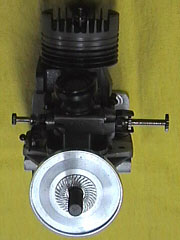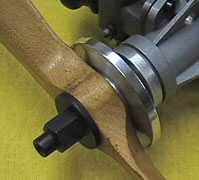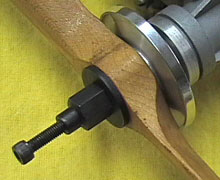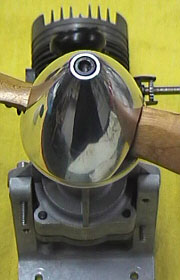Mounting a Spinner
Before you mount the spinner, you must ensure that the propeller(s) you
intend to use with it do not touch the cut-outs in the spinner. Contact
with the cut-out can cause catastrophic failure of the propeller and
possibly the spinner. Better manufacturers will cut your spinner
properly for the propeller for a small fee.
In my mind it is worth it
for two reasons: First, it will probably be done right. They
have the equipment and the know-how. Second, it makes them liable if
you use the product properly and it fails due to a defect in the cut-out.
If you choose to make the cut-outs yourself then try to keep them as
symmetrical as possible so that you do not take the spinner out of balance.
There are a lot of ways to make the cut-outs but this page does not discuss
them. Seek assistance from an experienced modeler before you start
hacking away at your spinner.
After the cut-outs are properly made you can mount the spinner and
propeller to the engine.
 |
All two piece spinners have a separate back
plate that is held in place by the propeller and prop nut. |
 |
An adapter nut is used in addition to or
instead of the prop nut. |
 |
The bolt shown here holds the cone in place.
The spinner cone goes in place before the bolt though.
 |
 |
The spinner cone in place. Do not
over-tighten the cone retaining bolt. You can crack the spinner or stress it to
the point where it could crack in use sending shards of metal flying in
all directions. |
|
![]()